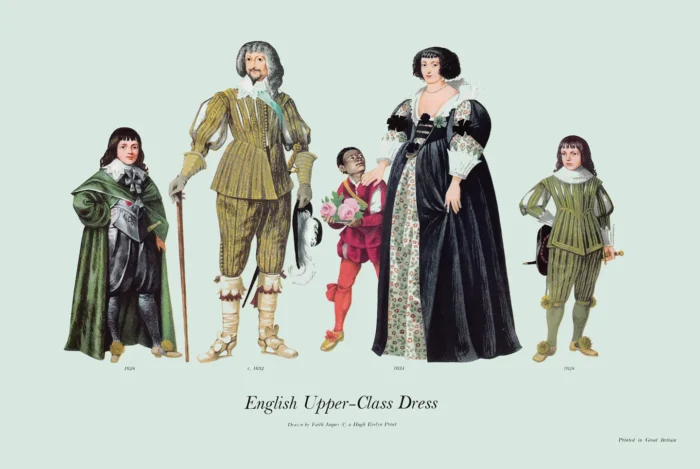English Upper-Class Dress, 1628-1634
£10.00
English Upper-Class Dress, 1628-1634 (scroll down for a more detailed Description)
Published 1968 by © Hugh Evelyn Limited; drawn by Faith Jaques
Size: c. 38 x 25.5 cm [15″ x 10″] may vary slightly from printers’ cut 50 years ago
Printed on medium cardstock weighing 151 g/sm2 faced in light greyish cyan – lime green (RGB: c. d8e8e0)
Print is STANDARD size – shipping is the same for 1 to 10 prints (based on largest print size in your order) – see Shipping & Returns.
In stock
Description
English taste was influenced by the example of King Charles I and his beautiful wife, Henrietta Maria. Their behaviour set the pattern for a society where originality and taste had begun to appear in Europe to change the style of costume. The look of ease and serenity, from a more civilized life, was also due to costume that allowed its wearers to breathe and relax. Men were first to loosen up: the strife that had ravaged Europe had shown the difficulty of conducting warfare in uncomfortable clothing. Padding left jerkins and doublets and the stiff waistline was loosened and lifted. Slits were made in body pieces to allow movement, and fastening was of buttons and loops. Shoulder width was retained by caps, or piccadils, which finished the armhole of a jerkin or protruded over the sleeve of a doublet. The finish to the waist was lengthened into shaped overlapping skirt pieces and covered the waist of long breeches fitted to the knee. Sleeves became loose with no padding but sporting a slit intended to give elbow room but became a feature with fancy shirt peeping through. A man was now wearing something resembling a suit. Boots had heels for the martial life of many. The wide tops of soft leather to ease over the foot, and for riding worn over the knee. For walking the tops were turned over to a cuff and the silk stockings were turned over likewise with fancy hems that reached almost to the cuff of the boot. With more flowing lines men grew their hair in soft curls to the shoulder which ousted the ruff, which dropped till lying flat like a collar. The little turned-down collar worn by sailors and poets was then employed to make the wide spreading lace collar that is typical of the period. Hats lost their crowns and became wide-brimmed felts. Men’s clothes became lacier and more feathered in the exhibitionist manner – emphasizing hardness by the contrast. Charles had ordered Inigo Jones to fashion a lovely house for Henrietta Maria at Greenwich. The French embraced the new fashion. The Queen’s gowns became high fashion. The silhouette widened with a gradual drooping of the shoulders. The waist was high and loose fitting from which the skirt flowed in soft folds, over small pads, to the ground. The bodice often copied the male tunic with tabs to finish the waistline but the stomacher was sometimes retained as a detail, shortened and tied across the waist with a ribbon. The neckline was wide with the Medici collar rising from the sides and turned over, with only the back still standing in a small fan behind the neck. The next step in fashion completely flattened the collar into a wide sweep that covered the shoulders. Sleeves were like those of the men with slits to show the underdress and were wide-cuffed with linen and lace to give a shortened appearance. As the shoulders widened and drooped, so the hair flattened on top and widened in short curls at each side. A fashion for coloured pages was another unfortunate outcome of the appalling slave trade in the new colonies of America and the West Indies
Additional information
| Dimensions | 38.1 × 25.5 cm |
|---|





